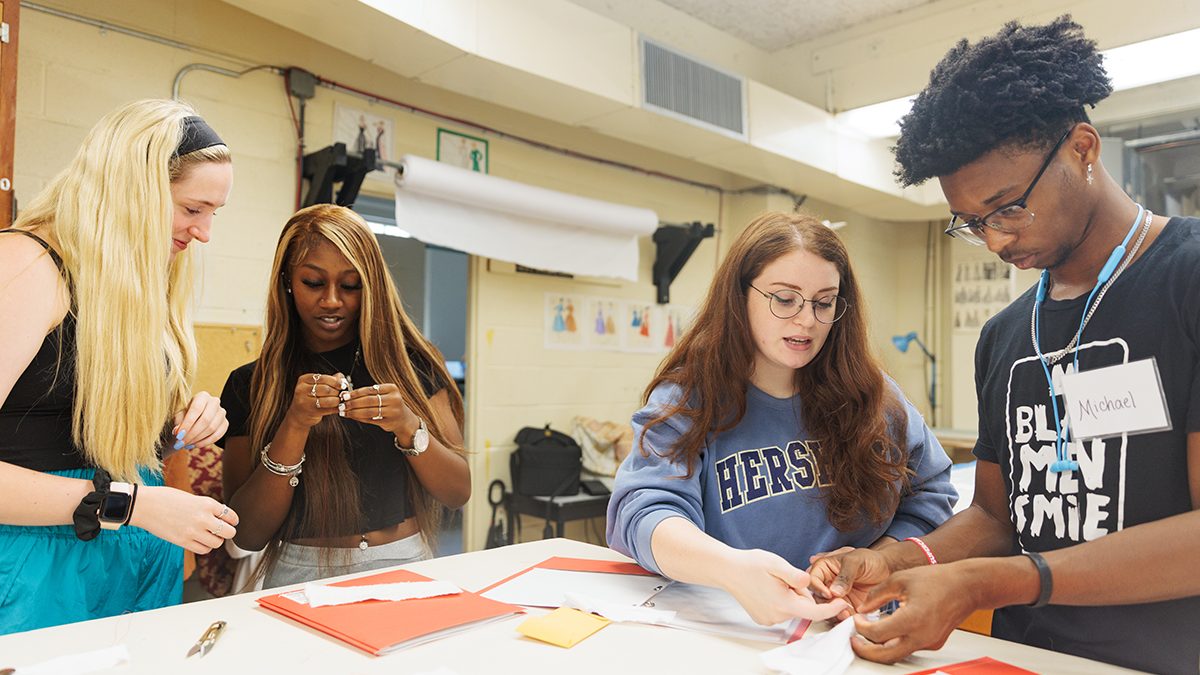Before the curtain goes up and the lights go down, a myriad of people are working behind the scenes to make sure every performance comes together perfectly. Stagehands, lighting technicians, set and costume designers, choreographers and more work tirelessly to impress the audience and serve the performers well — proving that the talent is not just on the stage, but behind it, beside it and in front of it as well.
UA’s Department of Theatre and Dance launches its 2022-2023 season on Sept. 26 with the first of seven theatrical productions and four dance performances — the preparation for which took many months of work for faculty, staff and students in the department.
“We start at least a year in advance choosing the productions. Those choices revolve around the students and what they need for their degrees,” said Randy deCelle, associate professor and production manager for the theatrical season. “Assignments are made in the spring, then we start holding meetings.”

Once productions are chosen, the months leading up to the new season pass swiftly.
“We meet with the director to learn their vision,” deCelle said. “Then we go to the scenic designer and director and start creative team meetings. We continue meeting over the summer.”
From there, technical drafts turn into models, then scale models, and the technical director will get the set fabrication started within that team. Each team has its own schedule that must coordinate with all other teams.
The passion or love you think a performer or artist has, the production team has that same passion, and it shows through their work.
“We have three productions overlapping right now,” said deCelle. “It’s a world of logistics.”
deCelle’s experience includes automation design on Broadway and stage productions in London, New York City and Celine Dion’s Las Vegas residency. That experience partnered with his continued work in consulting and design helped to hone his production wrangling skills. “I’m more responsible for handling the budget, the timetables, and all of those schedules,” he said.
One to two weeks before the first show, the crews get together for Tech Week, where the leaders for each part of production discuss the season’s needs.

“On that first one or two days of Tech Week, we’re seeing a dry run of the show,” said Lyndell McDonald, who is the technical supervisor for the dance department. “We see the dancers perform and the techs talk about each number. We’re adding technical elements every day that week and running the show non-stop. That last day we work with costuming to make sure we’re using the best lighting there as well.”
McDonald explained there are at least five to seven crew members for every dance performance, including crew members manning the light boards and soundboard, stage crew members and sometimes costume dressers.
“The production side is a collaboration process. We’re all working with choreographers, directors, the lighting team, composers, stage managers and scenic design,” he said.
“Dance is different [from theatre] because we’re working with several choreographers on how to set up for each production and each individual piece. And there can be multiple choreographers in one show.”
McDonald’s experience lends itself to knowing even the most minute technical aspects of a show are important. His specialty is lighting design, and his theatre design and production design credits include productions for such artists as Jay-Z and Miranda Lambert as well as several theatre companies. Most recently, he lead staging and production for the opening and closing ceremonies of the 2022 World Games in Birmingham.
“People don’t always realize how important the technical aspects of production are,” McDonald said. “Lighting helps with mood, setting the atmosphere, and can guide the audience on what to see …and what not to see.”



Both deCelle and McDonald agree that audiences likely never fully see the work and talent that goes into making the audience feel something from every performance, but it is unknowingly present.
“There are 10-20 people per cast member doing work that is often unnoticed by the audience,” deCelle said.
Many of those roles are filled by students working under arts management, which runs the business office for the production side of the theatre and dance department but performs different tasks than the administrative operations for the department.
“Some roles under arts management tend to work independently between theatre and dance, but we support each other and often students will work in both,” added deCelle.
Most of those overlapping student roles include performers, design and technical production, stage managers, costuming, projection design, light and technical engineering, set construction, prop artisans, hair and makeup artists and welders. The list of skillsets the students, faculty and staff bring to even one production could go on and on.
“The passion or love you think a performer or artist has, the production team has that same passion and it shows through their work,” added McDonald. “All gifts or talents aren’t seen, but they can be felt.”
The department’s first theatrical production, Gloria, a dark comedy set in a fictional New York City publisher’s office, runs Sept. 26-Oct. 2 in the Allen Bales Theater. The dance program’s first performance, the Alabama Repertory Dance Theatre fall production featuring choreography by UA’s nationally acclaimed dance faculty, runs Oct. 19-21 at the Dance Theatre.
Quick Info
UA Department of Theatre and Dance 2022-2023 Season
Contact
Jennifer Brady, UA Strategic Communications, jennifer.brady@ua.edu
